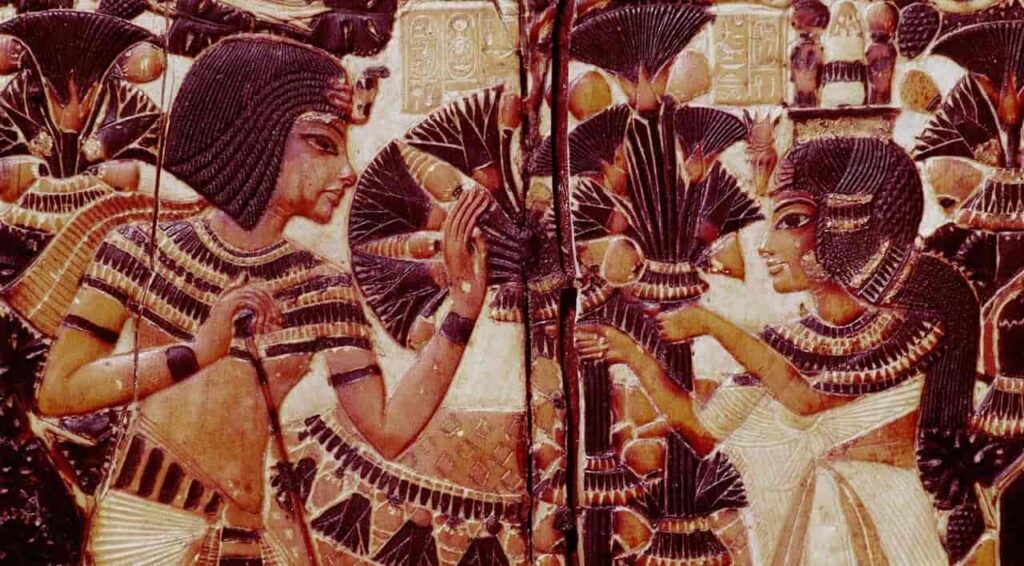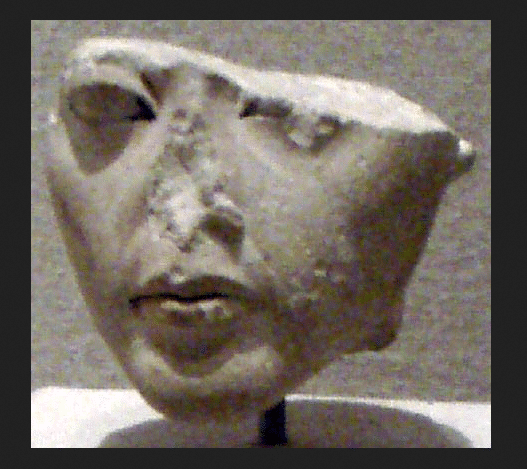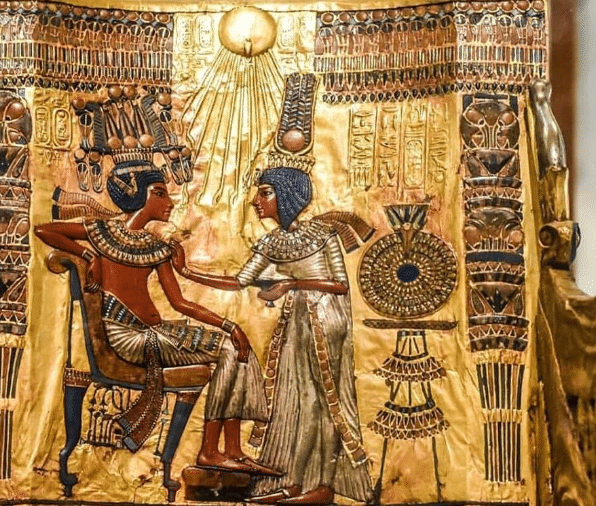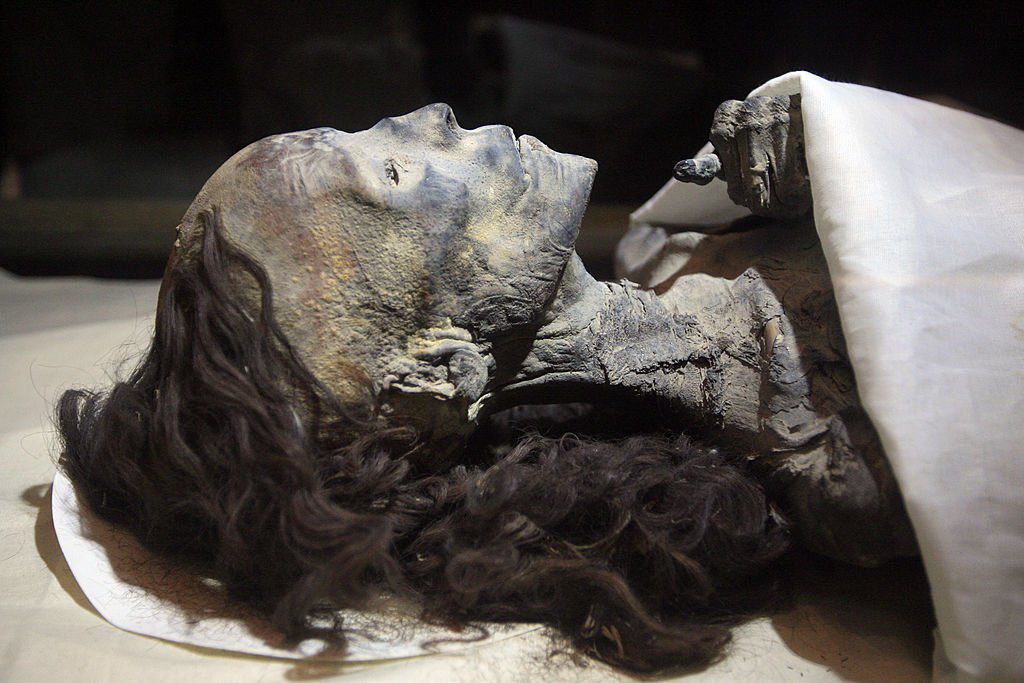Ankhesenamun was born around 1348 BC, during the Eighteenth Egyptian Dynasty and fourth year of the reign of her father Akhenaten.
The greatest and best sources that we have about her life are various relief and paintings, mostly depicting not her reign but the reign of her parents.
Throughout the queen’s life, Egypt was, uncharacteristically, a place of much religious upheaval. The old Gods were banished for the new god, Aten. The religious change is shown in her name which means ‘Life of Amun’.
Her true birth date remains a mystery, but it is known that she is the third youngest princess. With her sisters Meritaten and Meketaten, she became “Senior Princess”. They had many royal as well as religious obligations to attend to year round.
Her reign as queen was short, lasting only ten years, due to the death of her husband King Tutankhamun. Ankhesenamun died in 1322 BC, at the very young age of twenty-eight.
Ankhesenamun’s Parents
She was born to the famous, great royal wife Nefertiti and the Religious reformer Pharaoh Akhenaten.
During the first five years of his reign, her father was known as Amenhotep IV. His new name, which he adopted after he and his wife led the religious revolution from polytheism to monotheism, means ‘Effective for Aten’.
He moved the royal capital into a new city which he constructed to the glory of his new found god. The new capital was called Akhetaten, and was lost to history all up until the nineteenth century.
His reign was considered shameful by most pharaohs that followed him. They tried to erase every historical footprint that this, in their eyes, traitor and enemy set. He was even left out of the royal record books.
Her mother was a woman of many titles, for example, The Hereditary Princess, Lady of Grace, Sweet of Love, and Lady of all Women etc.
Her bust is one of the most depicted and famous examples of Egyptian art, of which both she and her husband were great patrons.
There are a plethora of theories about her death. Some say that she died of sudden illness, others that she was disgraced and banished.
Newer theories suggest that she lived longer than first thought. Some even speculate that she replaced her husband after his death and reigned as the pharaoh Neferneferuaten.
Ankhesenamun’s Husband
There is much intrigue and speculation surrounding her husband, Tutankhamun.
Born Tutankaten, meaning “Living Image of Aten” he later changed his name to Tutankhamun, meaning “Living Image of Amun“.
The name change signifies his return to the old polytheistic religion. Five years younger than his wife, they married very young; she was thirteen and he was eight years old.
Many historians nickname him the boy king. It is debatable how much influence he and his queen really had. Some speculate that the real ruler behind the scenes was the Grand Vizier Ay.
His reign was on the short side—only ten years. Historical records about his death are scarce. But where history has failed us, modern science has shown the way.
CT scans have discovered that he had fractured his left leg. It wasn’t treated properly and got infected.
His tomb, nearly untouched, was discovered at the beginning of the 20th century. Buried with him were his two stillborn children. Their likely mother was queen Ankhesenamun.
Ankhesenamun’s Later Life and Death
It is believed that she was the bride of her own father until his death. Even to moderns it seems unthinkable, and in most cases forbidden by law; in ancient Egypt that was the law itself.
Pharaohs and their families were seen as the living embodiment of gods. So, to keep the royal and godly lineage pure, they had to marry within the family.
Her husband king Tut was also a blood relation: her half-brother. She is believed to be Tut’s only wife. After the death of her husband, she suddenly disappears from history.
Some thought that the Grand Vizier Ay married her, thinking that marrying a popular queen and restorer of the former faith could prove to be a wise move to fortify his position as Pharaoh.
But that is unlikely. On Ay’s tomb, the name of his wife isn’t Ankhesenamun, but Tey, his senior wife.
She is the most likely person, next to her mother Nefertiti, to be the subject of the letter that the Hittites had from an Egyptian queen called Dakhamunzu.
The sad queen writes to the Hittite king Suppiluliuma I. She wrote that she and her later husband didn’t have any sons and begs him to send her one of his many sons to marry and have children with.
She ends the letter exclaiming, “I am afraid”. Egyptians considered foreigners to be far below them, so we can understand that the Hittite king saw that letter as the biggest surprise of his life.
Ankhesenamun’s Possible Tomb
Even though there are no historical clues to where and how the queen died, or where and when she was buried, some new findings could finally shed light on that over-three-millennia-old mystery.
During the summer of 2017, scientists started using high tech radars around the area of the tomb of the Great Vizier and later Pharaoh Ay, located in the Valley of the Monkey.
What they discovered was four foundations, which could lead to a discovery of an unknown tomb in its close proximity.
The leader of the expedition, Zahi Hawass, said he remains skeptical of the possibility that the possible tomb might indeed be the tomb of the vanished history queen Ankhesenamun.
With DNA testing showing various genetic diseases pillaging most of her family, it is highly likely that she also suffered.
Her husband had traces of malaria infections, which could also possibly be the reason for her death.
Ankhesenamun’s Possible Mummies
The KV21 site in the Valley of the Kings holds many secrets. But is it also where Ankhesenamun lies?
Some believe so. A DNA testing during February of 2010 revealed that a mummy designated KV21A holds DNA connecting her to the king Tut.
That brings us to only two possible candidates: queen Ankhesenamun, or her mother Nefertiti. If that really is her, and the DNA tests show that her DNA and the DNA of the fetuses buried with King Tut match, there is a problem.
The DNA of the mummy designated as KV55, believed to the mummy of damned pharaoh and father of Akhesenamun, Akhenaten, doesn’t match.
This leads to three possible outcomes: mummy KV21A is another, unknown wife of king Tut; mummy KV55 is not her father, but one of his brothers that ruled after him.
Both mummies are who we think they are, but they aren’t biologically related. Seems like drama, intrigue and secret relationships were en vogue in royal courts throughout the ages.
There is another place which could potentially hold the burial place of queen Ankhesenamun. That tomb is designated as KV63.
It lies in the close proximity of Tut’s tomb, KV63. The main issue with that site is that it has no mummies, so DNA testing is impossible.
But the tomb has many other findings that could point towards the conclusion that queen Ankhesenamun was indeed buried there.
The tomb holds a female imprint on a coffin, traditional female clothing and jewellery. On the fragments from pottery we have the inscription Paaten.
The only known royal person who bore that new was our lost queen, because the name her parents gave her was Ankhesenpaaten.
Modern depictions
Even if the life, death and burial of queen Ankhesenamun are shredded in mystery and, even if her husband gets more of the publicity, she still draw a lot of interest and inspiration among modern artists, writers and creators of every sort.
She is often featured as the main character in novels, for example, Christian Jacqui uses her as the main character in his book La reine soleil.
The book was also turned into an animated film with the same name. Moyra Caldencott in her book “Tutankhamun and the Daughter of Ra” has her as the titular character.
Lucille Morrison and Allen Drury depict her life from early age till death but both create a narrative in which she has or castrated her vanishing out of history herself.
She was also depicted in film many times. The original movie from 1932 Mummy names her as the love of Imhotep. Her character also appears in the two Mummy remake movies, but she is spelled different in both of them.
In his trilogy of book surrounding the Akhenaten time in Egyptian history, PC Dohrety implicates her in the death of king Tut, as well as has her to marry a Hittite prince.
She even crossed into the comic’s realm in Chie Shinohara’s manga Red River, which depicts the events of the Hittite letter.










THESE ARTICLES ARE FABULOUS, KEEP THEM COMING PLEASE !!